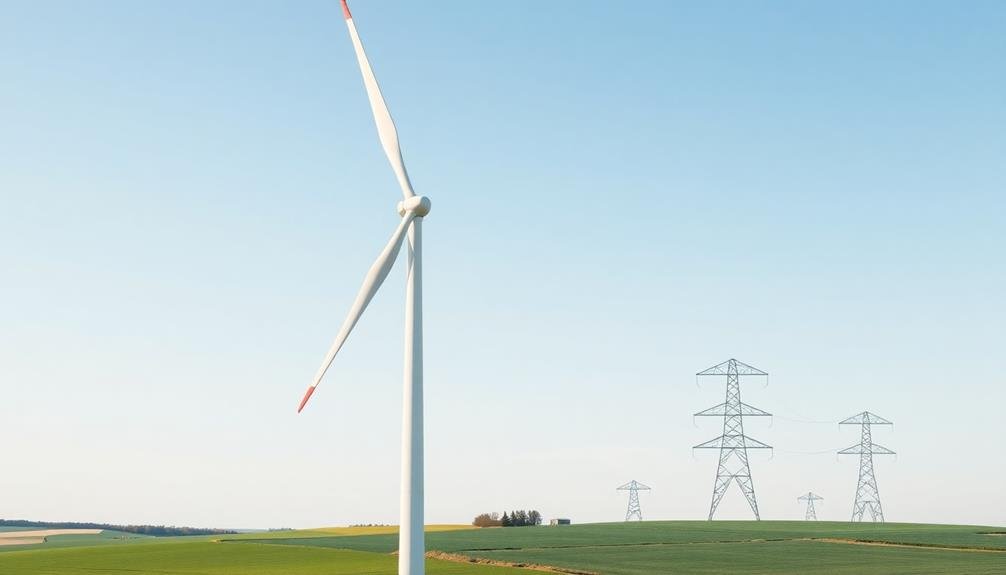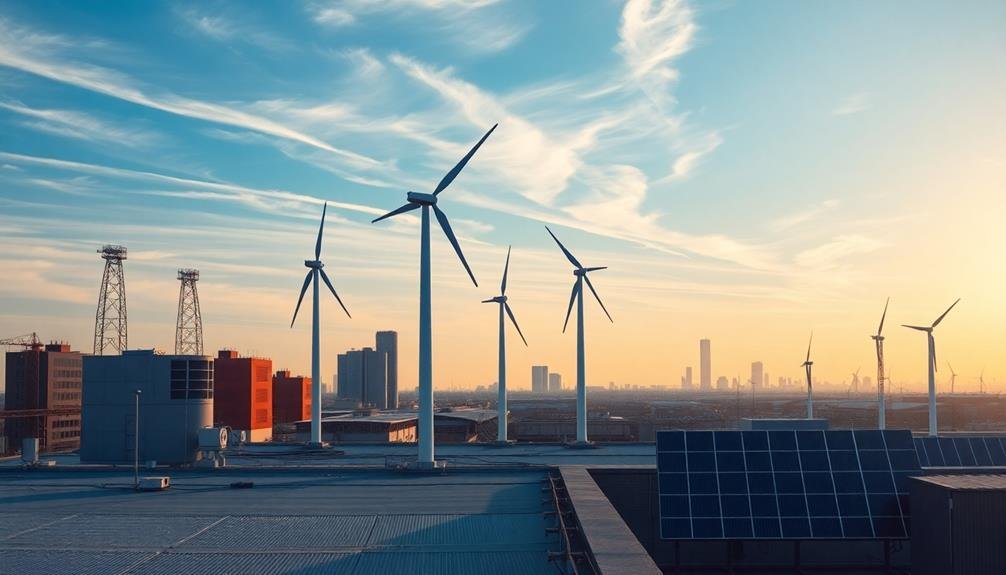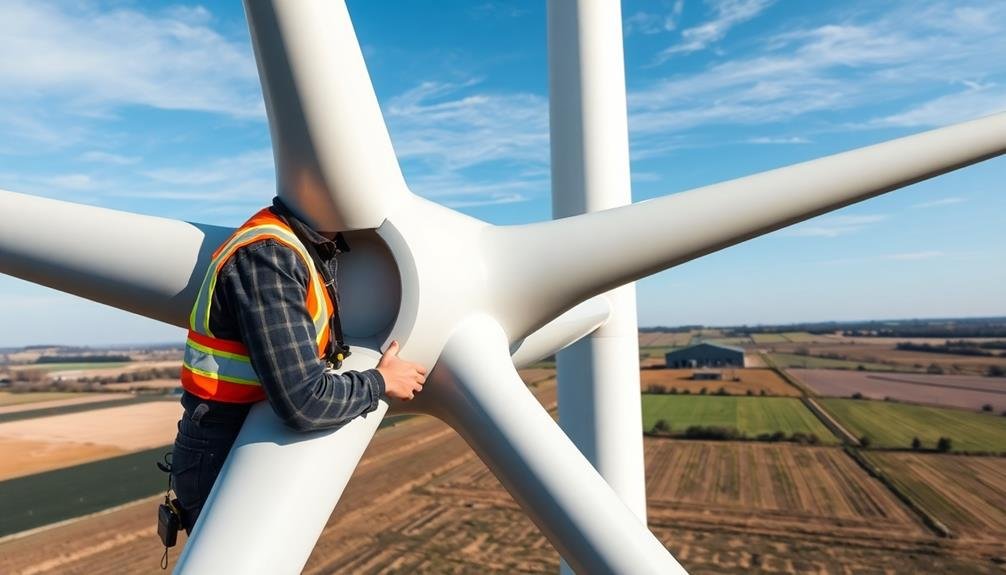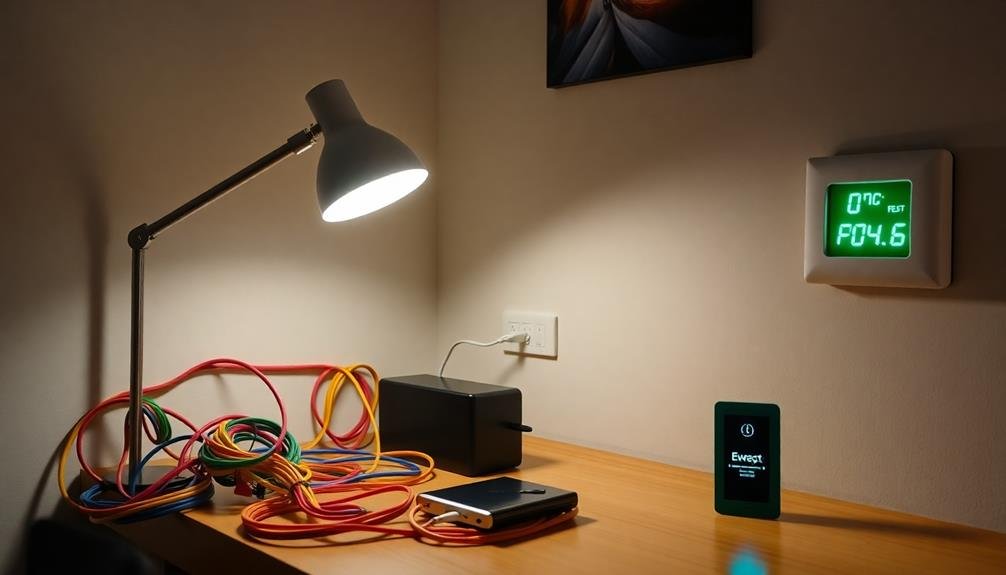Vertical axis wind turbines (VAWTs) produce clean, renewable electricity by harnessing wind energy. As wind pushes against their blades, they rotate around a vertical shaft, driving a generator to create electrical power. VAWTs can generate anywhere from 100 watts for small home applications to 10 kilowatts for larger installations. While generally less efficient than horizontal axis turbines, they excel in turbulent wind conditions and urban settings. VAWTs are quieter, have a smaller visual impact, and require less maintenance due to ground-level components. Their versatility and unique advantages make them an intriguing option for sustainable energy production. Discover how these innovative turbines could power your future.
Basics of Vertical Axis Turbines

Vertical axis wind turbines (VAWTs) spin around a central axis that's perpendicular to the ground, unlike their horizontal counterparts. They come in two main types: Darrieus and Savonius. Darrieus turbines use lift forces and look like eggbeaters, while Savonius turbines use drag forces and resemble split cylinders.
You'll find that VAWTs have several advantages. They're omnidirectional, meaning they don't need to face the wind to operate effectively. This makes them ideal for areas with turbulent or changing wind directions. They're also typically shorter than horizontal axis turbines, which can reduce visual impact and make maintenance easier.
However, VAWTs aren't without drawbacks. They're generally less efficient than horizontal axis turbines in converting wind energy to electricity. They also experience more turbulence near the ground, which can lead to increased wear and tear on the lower bearings.
When considering a VAWT, you'll need to weigh these factors against your specific needs. They're often used in urban or residential settings where space is limited and wind conditions are variable.
Understanding these basics will help you determine if a VAWT is the right choice for your energy production needs.
Energy Generation Process
You'll find that vertical axis wind turbines generate energy through a unique blade rotation mechanism.
As wind pushes against the turbine's curved blades, it causes them to spin around a vertical shaft.
This rotational energy is then converted into electricity through a generator connected to the shaft, which you can harness for various power needs.
Blade Rotation Mechanism
At the heart of a vertical axis wind turbine's energy generation process lies the blade rotation mechanism. Unlike horizontal axis turbines, vertical axis turbines don't need to face the wind direction. Instead, their blades are designed to capture wind from any angle, allowing for continuous rotation.
The blade rotation mechanism typically consists of two or more curved or straight blades attached to a vertical shaft. As wind hits these blades, it creates lift and drag forces, causing the shaft to spin. This rotation is the key to converting wind energy into mechanical energy.
You'll find two main types of blade designs: Darrieus and Savonius. Darrieus turbines use lift-based blades that resemble an eggbeater, while Savonius turbines employ drag-based blades shaped like half-cylinders. Both designs aim to maximize the turbine's efficiency in capturing wind energy.
The rotating shaft is connected to a generator, which converts the mechanical energy into electrical energy. As wind speeds increase, the blade rotation accelerates, leading to higher energy output.
This simple yet effective mechanism allows vertical axis wind turbines to harness wind power efficiently in various environments.
Electricity Conversion Process
Once the blade rotation mechanism sets the vertical shaft in motion, the electricity conversion process begins. The rotating shaft is connected to a generator, which is the heart of the energy production system.
As the shaft spins, it turns the rotor inside the generator, which is surrounded by stator coils. The rotation of the rotor, typically containing powerful magnets, creates a changing magnetic field. This field induces an electric current in the stator coils through electromagnetic induction.
The faster the rotor spins, the more electricity is generated. The generated electricity is initially in the form of alternating current (AC). However, it's often not suitable for immediate use due to its varying frequency and voltage.
To address this, the AC is typically sent through a rectifier to convert it to direct current (DC).
Power Output Capacity

You'll find that vertical axis wind turbines typically have a wattage range from 100W to 10kW, depending on their size and design.
Their power output capacity is influenced by several efficiency factors, including wind speed, blade aerodynamics, and generator performance.
When considering a vertical axis turbine, you'll need to assess these factors to determine the most suitable model for your energy needs.
Wattage Range
Vertical axis wind turbines' power output capacity varies widely, ranging from small-scale residential units to large commercial installations.
You'll find micro-turbines designed for home use that generate as little as 100 watts, suitable for powering small appliances or charging batteries. These compact units are ideal for off-grid applications or supplementing household energy needs.
At the other end of the spectrum, you'll encounter industrial-scale VAWTs capable of producing up to 4 megawatts of power. These massive turbines are typically used in wind farms or large-scale energy projects.
Between these extremes, you'll find a diverse array of mid-sized turbines producing anywhere from 1 kilowatt to 100 kilowatts.
It's important to note that a turbine's actual power output depends on various factors, including wind speed, rotor size, and overall efficiency.
Most residential VAWTs fall in the 1 to 10 kilowatt range, while small commercial units often produce between 10 to 50 kilowatts.
When choosing a VAWT, you'll need to evaluate your energy requirements, available space, and local wind conditions to determine the most appropriate wattage range for your needs.
Efficiency Factors
While the wattage range provides a general idea of a VAWT's capabilities, several efficiency factors profoundly impact its actual power output capacity. Wind speed is the most vital factor, as power output increases cubically with wind velocity. You'll find that most VAWTs reach their peak efficiency at wind speeds between 8-12 m/s.
The turbine's height and rotor diameter also play essential roles. Taller turbines can access stronger, more consistent winds, while larger rotor diameters capture more wind energy. However, you'll need to balance these factors with structural limitations and local regulations.
Blade design considerably affects efficiency. Airfoil-shaped blades generally perform better than flat ones, and the number of blades impacts start-up speed and overall performance. You'll also want to take into account the turbine's cut-in and cut-out speeds, which determine its operational range.
Environmental factors like air density, temperature, and terrain can influence efficiency. Urban settings may create turbulent airflow, reducing performance.
Additionally, mechanical factors such as generator efficiency, bearing friction, and transmission losses will affect the turbine's overall power output capacity.
Efficiency Compared to Horizontal Turbines
When comparing the efficiency of vertical axis wind turbines (VAWTs) to their horizontal counterparts (HAWTs), it's essential to take into account various factors. Generally, HAWTs are regarded as more efficient regarding power output per unit area. They can capture wind from any direction without the need for repositioning, which gives them an advantage in steady, unidirectional wind conditions.
However, VAWTs have their own strengths. They're typically more efficient in turbulent wind conditions, such as those found in urban environments. VAWTs can also operate at lower wind speeds, making them suitable for areas with less consistent wind patterns. Additionally, they're often quieter and pose less risk to birds and bats.
With respect to overall efficiency, HAWTs usually outperform VAWTs, with some models achieving efficiencies of up to 45%, compared to VAWTs' typical range of 30-40%.
However, recent advancements in VAWT design have narrowed this gap. It's significant to note that efficiency isn't the only aspect to take into account when choosing between turbine types. Site-specific conditions, installation costs, and maintenance requirements should also play a role in your decision-making process.
Factors Affecting Energy Production

When considering the energy production of vertical axis wind turbines, you'll need to account for several key factors.
Wind speed and consistency play a vital role, as does the size and efficiency of your chosen turbine model.
You'll also want to carefully evaluate environmental placement considerations to maximize your turbine's performance.
Wind Speed and Consistency
Two key factors markedly influence the energy production of vertical axis wind turbines: wind speed and consistency.
Wind speed directly impacts the amount of energy a turbine can generate. You'll find that most VAWTs start producing power at wind speeds of 3-5 m/s, reaching their rated capacity at around 12-15 m/s. Higher wind speeds generally result in more energy production, but there's a limit. Many turbines have a cut-out speed, typically around 25 m/s, where they'll shut down to prevent damage.
Consistency is equally significant. Steady winds are ideal for VAWTs, as they allow for continuous energy production. Turbulent or gusty conditions can reduce efficiency and increase wear on the turbine. You'll want to evaluate the average wind speeds and patterns at your location when reflecting on potential energy output.
It's important to note that VAWTs can handle changes in wind direction better than their horizontal axis counterparts. This makes them particularly suitable for urban environments or areas with unpredictable wind patterns.
However, they still perform best with consistent wind flow, so choosing an appropriate site is essential for maximizing energy production.
Turbine Size and Efficiency
Beyond wind characteristics, the size and efficiency of vertical axis wind turbines play significant roles in energy production. The larger the turbine, the more wind it can capture and convert into electricity. However, bigger isn't always better, as larger turbines require stronger winds to operate effectively.
Efficiency is vital in determining a turbine's output. Modern vertical axis wind turbines can achieve efficiency rates of up to 35%, though this varies based on design and environmental factors. You'll find that Darrieus-type turbines generally have higher efficiency than Savonius-type models.
When selecting a turbine, consider the trade-offs between size, efficiency, and your specific energy needs:
| Size | Efficiency | Best Use Case |
|---|---|---|
| Small | Low | Residential, off-grid applications |
| Medium | Moderate | Small businesses, farms |
| Large | High | Commercial, industrial sites |
| Very Large | Highest | Utility-scale power generation |
| Custom | Varies | Specialized applications |
Remember that a turbine's performance is also influenced by its height. Taller installations can access stronger, more consistent winds, potentially increasing energy production. By carefully considering size and efficiency factors, you'll maximize your vertical axis wind turbine's energy output.
Environmental Placement Considerations
Environmental placement factors play an essential role in the energy production of vertical axis wind turbines. When considering where to install these turbines, you'll need to evaluate wind patterns, terrain, and surrounding structures.
Look for areas with consistent wind speeds, as VAWTs perform best in steady airflow. Coastal regions, open plains, and mountain passes often provide ideal conditions.
You'll want to avoid placing turbines near tall buildings or natural obstructions that can create turbulence. However, VAWTs can handle turbulent winds better than their horizontal-axis counterparts, making them suitable for urban environments.
Consider the height at which you'll mount the turbine; higher elevations generally offer stronger winds.
Don't forget to account for seasonal variations in wind patterns. Some locations may experience significant changes throughout the year, affecting energy production.
You should also evaluate the environmental impact of your turbine placement, considering factors like bird migration routes and noise pollution.
Finally, make sure you comply with local zoning laws and regulations regarding wind turbine installations.
Residential Applications
Vertical axis wind turbines (VAWTs) are gaining popularity in residential settings due to their compact design and ability to operate in turbulent wind conditions.
These turbines can be installed on rooftops or in small yards, making them ideal for urban and suburban homes. You'll find that VAWTs are quieter than traditional horizontal axis turbines, reducing noise pollution for you and your neighbors.
When considering a VAWT for your home, you'll need to assess your energy needs and local wind patterns. Most residential VAWTs generate between 1 to 10 kilowatts of power, depending on their size and wind conditions. You can use this energy to supplement your grid electricity or, in some cases, go off-grid entirely.
Installation costs vary, but you'll typically spend between $2,000 to $5,000 per kilowatt of capacity.
Don't forget to check local zoning laws and homeowners' association rules before installing a VAWT. Many areas offer incentives or tax credits for renewable energy systems, which can help offset your initial investment.
Maintenance is relatively simple, with most VAWTs requiring annual inspections and occasional blade cleaning to guarantee peak performance.
Commercial and Industrial Uses

For commercial and industrial applications, vertical axis wind turbines (VAWTs) offer unique advantages over their horizontal counterparts. They're particularly well-suited for urban environments, where space is limited and wind conditions are often turbulent.
You'll find VAWTs installed on rooftops of office buildings, factories, and warehouses, harnessing wind energy without the need for extensive land use.
In industrial settings, VAWTs can be integrated into existing infrastructure, providing supplementary power to manufacturing processes or data centers. They're also valuable in remote locations, such as mining sites or offshore platforms, where traditional energy sources may be unreliable or costly.
VAWTs excel in areas with high turbulence, making them ideal for use near airports, ports, and along highways. You'll see them powering roadside equipment, communication towers, and even electric vehicle charging stations.
For large-scale commercial wind farms, VAWTs can be placed closer together than horizontal axis turbines, potentially increasing energy output per acre.
They're also easier to maintain, as most mechanical components are located at ground level, reducing downtime and operational costs for businesses relying on wind energy.
Environmental Impact
When it comes to environmental impact, vertical axis wind turbines (VAWTs) offer several advantages over their horizontal counterparts. They're generally smaller and more compact, which means they require less land area for installation. This reduced footprint can help preserve natural habitats and minimize ecosystem disruption.
You'll find that VAWTs have a lower visual impact on landscapes, as they're often shorter than traditional wind turbines. This can make them more acceptable in urban or suburban areas where aesthetics are a concern. They also tend to operate more quietly, reducing noise pollution for nearby residents and wildlife.
VAWTs can be beneficial for bird and bat populations. Their slower rotational speeds and vertical orientation make them more visible to flying creatures, potentially reducing collision risks. Additionally, you'll notice that VAWTs don't require as much maintenance, which means fewer service visits and less environmental disturbance over time.
However, it's important to take into account that VAWTs still have some environmental impacts. Like all wind turbines, they can affect local wind patterns and may contribute to minor changes in microclimate.
You should also be aware that manufacturing and transporting these turbines still involves some carbon emissions, although they're offset by clean energy production over the turbine's lifetime.
Maintenance and Longevity

How do vertical axis wind turbines fare when it comes to maintenance and longevity? You'll find that these turbines generally require less maintenance than their horizontal-axis counterparts.
Their design allows for easier access to critical components, as the generator and gearbox are typically located at ground level. This accessibility reduces the need for specialized equipment and lowers maintenance costs.
VAWTs also tend to have a longer lifespan, often lasting 20 to 30 years with proper care. Their simpler construction means fewer moving parts, which translates to less wear and tear over time.
You'll need to perform regular inspections, lubrication, and occasional replacements of bearings and blades to guarantee peak performance.
One advantage of VAWTs is their ability to withstand harsh weather conditions better than horizontal-axis turbines. They're less susceptible to damage from high winds and can continue operating in turbulent environments.
However, you should still conduct thorough checks after severe weather events to identify any potential issues.
To maximize longevity, you'll want to implement a proactive maintenance schedule, addressing minor problems before they escalate. This approach will help you extend the turbine's operational life and maintain its energy production efficiency over time.
Cost-Effectiveness Analysis
Dollars and cents play an essential role when evaluating vertical axis wind turbines (VAWTs) for energy production. When you're considering VAWTs, you'll need to factor in various costs, including initial investment, installation, maintenance, and operational expenses. These costs can vary considerably depending on the turbine's size, design, and location.
You'll find that VAWTs often have lower upfront costs compared to their horizontal-axis counterparts. They're typically smaller and require less complex installation processes. However, their energy output is generally lower, which can impact long-term cost-effectiveness.
To determine if a VAWT is cost-effective for your needs, you'll need to calculate the levelized cost of energy (LCOE). This metric takes into account the total lifetime costs divided by the total energy produced. You should also consider factors like wind resources in your area, local electricity rates, and available incentives or subsidies.
It's important to note that as technology improves and production scales up, the cost-effectiveness of VAWTs is likely to increase. You'll want to stay informed about the latest advancements and market trends to make the most economical choice for your energy needs.
Installation Considerations

Beyond cost factors, the installation process for vertical axis wind turbines (VAWTs) requires careful planning and execution.
You'll need to assess the site's wind conditions, available space, and local regulations before proceeding. VAWTs can be installed in urban areas and on rooftops, making them versatile options for various environments.
When installing a VAWT, you'll need to take into account:
- Foundation requirements
- Tower height and structural support
- Electrical connections and grid integration
You must guarantee proper anchoring and foundation construction to withstand the turbine's weight and dynamic forces.
The tower's height should be fine-tuned for maximum wind exposure while complying with local zoning laws. Additionally, you'll need to plan for the electrical system, including inverters and potential battery storage.
Safety is paramount during installation. You should hire experienced professionals familiar with VAWT systems to handle the process.
They'll ensure proper alignment, balance, and secure connections. Regular maintenance post-installation is essential for peak performance and longevity.
Energy Storage Solutions
As wind speeds fluctuate, efficient energy storage becomes essential for vertical axis wind turbines.
You'll find that battery systems are the most common storage solution for these turbines. Lithium-ion batteries offer high energy density and long lifespans, making them ideal for storing excess energy during peak production times.
You can also consider flywheel energy storage systems, which store kinetic energy in a rotating mass. These systems provide rapid response times and are well-suited for short-term energy storage needs.
For larger-scale applications, you might opt for pumped hydro storage. This method involves pumping water to a higher elevation reservoir during excess energy production and releasing it through turbines when energy is needed.
Hydrogen storage is another emerging option. You can use excess electricity to produce hydrogen through electrolysis, which can be stored and later used in fuel cells or combustion engines.
Thermal energy storage systems, such as molten salt tanks, can be effective for storing heat generated by wind turbines, which you can later convert to electricity.
Future Developments and Innovations

While energy storage solutions enhance the reliability of vertical axis wind turbines, ongoing research promises to revolutionize their design and performance. Engineers are exploring innovative materials and shapes to improve efficiency and durability.
You'll see advancements in blade design, with researchers developing airfoils that can capture more wind energy at lower speeds. They're also working on smart turbine systems that can adapt to changing wind conditions in real-time.
The integration of artificial intelligence and machine learning algorithms will optimize turbine operation and maintenance. You can expect these technologies to predict wind patterns, adjust blade angles, and detect potential issues before they become problems. This will lead to increased energy production and reduced downtime.
Some exciting future developments include:
- Self-healing materials for blade construction
- Modular designs for easier installation and maintenance
- Hybrid systems combining vertical axis turbines with solar panels
As vertical axis wind turbines continue to evolve, you'll see them become more efficient, cost-effective, and versatile. These innovations will make them increasingly attractive for both urban and rural applications, potentially transforming the renewable energy landscape.
Frequently Asked Questions
Can Vertical Axis Wind Turbines Be Used in Urban Environments?
Yes, you can use vertical axis wind turbines in urban environments. They're well-suited for cities due to their compact design, ability to handle turbulent winds, and lower noise levels. You'll find them on rooftops and in small spaces.
Do Vertical Axis Turbines Produce Noise Pollution?
You'll find that vertical axis turbines do produce some noise, but it's typically less than horizontal turbines. They're quieter due to their lower blade tip speed. However, you'll still hear a low hum during operation.
How Do Birds and Bats Interact With Vertical Axis Wind Turbines?
You'll find that birds and bats interact less with vertical axis turbines compared to horizontal ones. They're more visible and spin slower, reducing collision risks. However, some impacts still occur, so careful siting and monitoring remain important.
Are There Any Hybrid Systems Combining Vertical Axis Turbines With Solar Panels?
Yes, you'll find hybrid systems combining vertical axis turbines with solar panels. They're called solar-wind hybrid systems. You can integrate these technologies to maximize energy production, especially in areas with varying wind and sun conditions.
Can Vertical Axis Turbines Be Used for Water Pumping or Desalination?
Yes, you can use vertical axis turbines for water pumping and desalination. They're versatile and can power various systems. You'll find them particularly useful in remote areas where traditional energy sources aren't readily available.
In Summary
You've explored the ins and outs of vertical axis wind turbines and their energy production. While they're not as common as horizontal turbines, they offer unique advantages in certain situations. As you consider renewable energy options, remember that vertical axis turbines can be a viable choice, especially in urban or low-wind areas. Keep an eye on future innovations in this field, as they may further improve efficiency and cost-effectiveness.





Leave a Reply